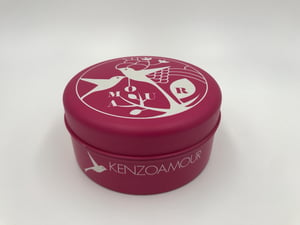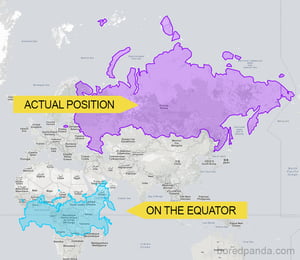Printing on circular and round objects is often a very challenging task. When an image designed for a flat surface is placed on a curved object it can become distorted. This can be seen on maps of earth. This article explains how anamorphic correction can produce compelling results.
Earth is round, so when it is drawn on a flat surface parts of it become stretched. Our maps are typically shown using a Mercator projection, which makes areas near the top and bottom of the map appear much larger than they really are. On maps Russia appears to make up 25% of earth’s landmass, but in reality it only makes up 5%. This is a 500% increase in relative size [1, 2].
The opposite of the Mercator project of Earth is what makes printing metal cans challenging. Instead of starting with a curved object (earth) and creating a flat object (map) it is the opposite, starting with a flat object and ending with a curved one. When a label for a can is printed the distortion must be taken into consideration [3]. This means that when a label is printed on a flat surface it will appear distorted, but when it is bent into its final shape it will appear with the correct proportions.
Anamorphosis
The distortion that is created by moving an image between round and flat objects is a type of anamorphic projection called anamorphosis. An anamorphic projection is an image that appears distorted from one viewpoint, but correctly when viewed from a different angle [3]. We see this type of distortion on a daily basis with things like advertising on curved buildings, IMAX movie screens, and aluminum cans. Additionally, it is often used in art like in the works of Jonty Hurwitz and Salvador Dali [4].
Anamorphosis on Tin and Aluminum Cans
 Typically, labels on metal cans are directly printed, painted, or engraved onto the metal. This is done over a few steps and can be quite challenging, but when the right program and machinery is used it has great results.
Typically, labels on metal cans are directly printed, painted, or engraved onto the metal. This is done over a few steps and can be quite challenging, but when the right program and machinery is used it has great results.
The design process is done with the assistance of computer programs. The first major step in the procedure is to create a 3D template of the can being created. This provides the exact curvature and shape of the can’s design. Next, the program adds the label design to the 3D template. The computer program uses calculations to mimic the anamorphic distortion that will occur.
The label design is automatically altered to create a final product that will have limited distortion [6]. Lastly, the can is rendered with the updated label design to provide a sample of what the final product will look like. Historically these steps were done by hand, requiring in depth calculations and lots of design drawings [7]. With the assistance of computer programs a lot of the process is now automated, largely increasing its reliability.
After the anamorphic tin design is created, it is coded into a printing station. Large sheets of metal are run though the printing station, which prints the design directly onto the metal. The metal sheet is then cut into the correct size and bent into the final cylindrical shape. Lastly, the top and bottom of the can are attached to create the final product [7]. The label will appear undistorted, as the computer rendering showed.
The use of computers has not only increased the reliability of designing metal cans, but it has allowed for more intricate and large designs. What used to be a very time consuming process is now much more streamlined. This provides artists with more freedom to design unique labels that meet the needs of their clients. Overall, it is a reliable process that is a necessity for companies that produce metal cans.

References
- [1] Snyder, John P (1993), Flattening the Earth: Two Thousand Years of Map Projections, University of Chicago Press, ISBN 0-226-76747-7
- [2] “The Problem with Our Maps.” Business Insider, Business Insider, 5 June 2017, www.businessinsider.com/the-mercator-projection-distorts-countries-2017-6.
- [3] Knoops, R. (2015). Cylindrical anamorphosis: Thaumaturgical origins and contemporary workings. Acoustic Space Journal, 14, 211-225.
- [4] Ades, ed. by Dawn (2000). Dalí's optical illusions : [Wadsworth Atheneum Museum of Art, January 21 - March 26, 2000 : Hirshhorn Museum and Sculpture Garden, April 19 - June 18, 2000 ; Scottish National Gallery of Modern Art, July 25 - October 1, 2000]. New Haven, Connecticut: Yale Univ. Press. pp. 17–18. ISBN 978-0300081770.
- [5] Cebal SAS. Method of Preparing Pre-Distorted Images for Decorating a Shaped Blank. 18 Sept. 1990.
- [6] “Metal Can 3D.” Beegraphic Srl, beegraphic.it/quadraxis/metal-can-3d/.
- [7] “CanCentral: Everything You Need to Know about Cans.” History of the Can - Can Manufacturers Institute | Washington, DC, www.cancentral.com/can-stats/how-cans-are-made.
Image: Anamorphic image projection of Russia on the Equator by james-talmage-damon-maneice was taken from Victoria G.'s article "Russia on the Euquator is not a giant bear" by courtesy of Bored Panda






